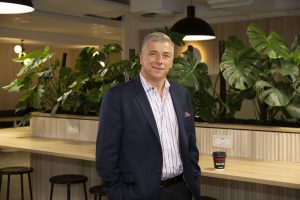In 2021, 7-Eleven Australia became “Australia’s first retailer to adopt a business wide way of working inspired by agile methodologies.”

According to 7-Eleven Australia CEO and Managing Director, Angus McKay, the transformation of the business is designed to enable the company’s ambition.
“We’re focused on delivering on our ambition to provide one billion customer moments per year by 2030. That’s a fourfold increase on the approximately 250 million transactions delivered in the last financial year,” he says.
“When we were setting the ambition, we realised that if we set the horizon to somewhere we already know how to get to, we would be limiting ourselves. The challenge we set was to aim for something that made us uncomfortable, that we didn’t know exactly how we were going to achieve.”
Mr McKay says that that to achieve the ambition the entire organisation needed to change.
“As our network grew, and we started to play more heavily in spaces such as digital and food, and push the boundaries in formats, we found that we couldn’t test, iterate and roll out as many new innovations as we wanted to. Being retailers there’s also that tendency to want everything perfect before it gets to your customer facing team,” he says.
“What our early forays into the digital space taught us is that our customers and store teams were willing to be part of the innovation process, meaning iterative design has huge potential for us.
“In traditional structures there are inevitable bottlenecks, and you don’t have the flexibility to move people around without impacting reporting lines, roles and budgets. There can also be challenges if outcomes aren’t clearly connected across departments and with business objectives.
“We decided that we wanted an agile structure made up of squads of people with mixed skill sets empowered to make the decisions needed to achieve key results that directly linked to the organisation’s quarterly metrics.”
Mr McKay says 7-Eleven is accelerating career development and learning opportunities for the company’s people as well as benefits for the customer and business growth.
“The ways of working separate career progression and learning opportunities from titles, hierarchy and renumeration,” he says.
“People develop skills and capabilities in their craft, as well as develop their leadership skills and business acumen by being part of various squads and projects. The way people progress and are rewarded is linked to their contribution and capabilities mapped against a specific model for their craft.
“The ways of working mean we can develop the right capabilities for the work that needs to get done, and for our people it sets them up to develop an amazing array of skills for their careers.”
Mr McKay says that for some, the ways of working might not be the right fit.
“If someone is motivated by their title, the size of their team, their place in a hierarchy, this way of working might not be right for them. For people that are motivated by the work they get to do, the skills they get to learn, developing their capability across their craft, in leadership and in their business acumen, and the chance to collaborate to deliver success as a team, this way of working is really exciting,” he says.
While the business is still in the early stages of this transformation, Mr McKay says there are early signs that it is making a difference for the company’s people and its customers.
“I’ve been in the corporate world for more than 20 years and practicing that new way of thinking every day is a challenge for all of us, me included. However, a model that lets people be proud of the work they’ve done, not the title they had, that uncovers those quiet achievers and empowers people to demonstrate what they are truly capable of, is sensational,” he says.
“One of our squads recently made significant changes to our sushi range to improve the quality of the products in response to customer feedback. In the past it would have taken about 24 weeks for the team to have new products in stores to test customer reaction, in our new way of working it took 12 weeks. I think the potential of the change across the business is extraordinary.”





